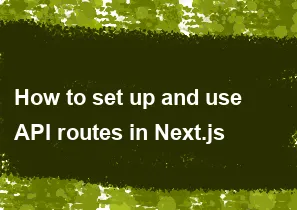How to set up and use API routes in Next.js

In Next.js, API routes are used to create serverless functions that can handle backend logic. These routes are stored in the pages/api directory and automatically become part of your Next.js application. Here's a step-by-step guide on how to set up and use API routes in Next.js:
Step 1: Create the API route
Create the
pages/apidirectory: Inside your Next.js project, create a folder namedapiinside thepagesdirectory. This is where you'll store your API route files.bashmkdir pages/apiCreate an API route file: Inside the
pages/apidirectory, create a new file for your API route. For example, create a file namedexample.js.javascript// pages/api/example.js export default function handler(req, res) { res.status(200).json({ message: 'Hello from the API!' }); }
Step 2: Use the API route in your application
Now that you've created the API route, you can use it in your components or pages.
Fetch data in a component or page: You can use the
fetchAPI or any other HTTP library to make a request to your API route.javascript// pages/index.js import React, { useEffect, useState } from 'react'; const Home = () => { const [data, setData] = useState(null); useEffect(() => { const fetchData = async () => { try { const response = await fetch('/api/example'); const result = await response.json(); setData(result); } catch (error) { console.error('Error fetching data:', error); } }; fetchData(); }, []); return ( <div> <h1>Hello Next.js</h1> {data && <p>{data.message}</p>} </div> ); }; export default Home;In this example, the component fetches data from the
exampleAPI route and displays the result.
Step 3: Start your Next.js application
Run your Next.js application:
bashnpm run dev
Visit http://localhost:3000 in your browser, and you should see your application displaying the data fetched from the API route.
That's it! You've successfully set up and used an API route in Next.js. You can now expand your API routes to handle more complex logic, database queries, or external API requests.
-
Popular Post
- How to optimize for Google's About This Result feature for local businesses
- How to implement multi-language support in an Express.js application
- How to handle and optimize for changes in mobile search behavior
- How to handle CORS in a Node.js application
- How to use Vue.js with a UI framework (e.g., Vuetify, Element UI)
- How to configure Laravel Telescope for monitoring and profiling API requests
- How to create a command-line tool using the Commander.js library in Node.js
- How to implement code splitting in a React.js application
- How to use the AWS SDK for Node.js to interact with various AWS services
- How to use the Node.js Stream API for efficient data processing
- How to implement a cookie parser middleware in Node.js
- How to implement WebSockets for real-time communication in React
-
Latest Post
- How to implement a dynamic form with dynamic field styling based on user input in Next.js
- How to create a custom hook for handling user interactions with the browser's device motion in Next.js
- How to create a custom hook for handling user interactions with the browser's battery status in Next.js
- How to implement a dynamic form with dynamic field visibility based on user input in Next.js
- How to implement a dynamic form with real-time collaboration features in Next.js
- How to create a custom hook for handling user interactions with the browser's media devices in Next.js
- How to use the useSWRInfinite hook for paginating data with a custom loading indicator in Next.js
- How to create a custom hook for handling user interactions with the browser's network status in Next.js
- How to create a custom hook for handling user interactions with the browser's location in Next.js
- How to implement a dynamic form with multi-language support in Next.js
- How to create a custom hook for handling user interactions with the browser's ambient light sensor in Next.js
- How to use the useHover hook for creating interactive image zoom effects in Next.js